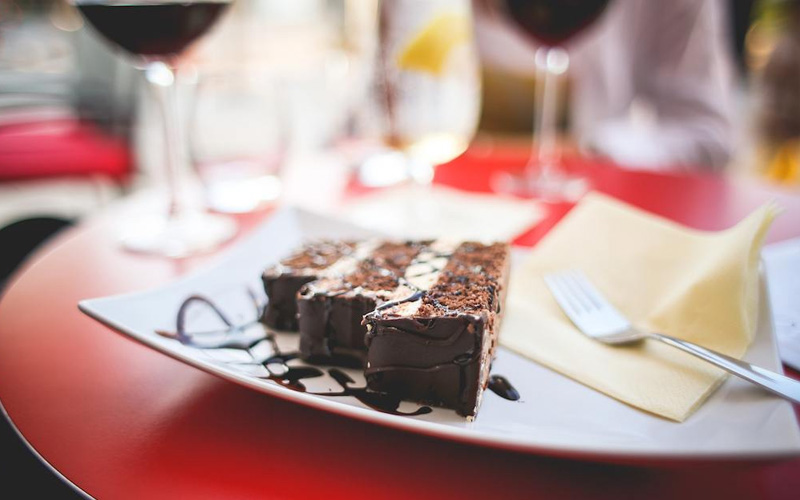
Let’s be honest, selling dessert shouldn’t be hard. Simply glancing at a display of sweet treats is enough to get your mouth watering. Dessert marketing, however, is the tough cookie of the restaurant business. If that delicious display of desserts isn’t presented well, it makes getting that final sale a little harder.
Using your website to help your treats stand out from the crowd is the cherry on top for restaurants with quality goods that are simply too good not to be shared.
There are, however, several other ways your restaurant marketing strategies can turn a casual “Would you like dessert?” offer at the end of the meal into a revenue generator.
In this article we’ll cover how to:
- Take advantage of restaurant social media for your desserts
- Train your servers on how to sell the dessert menu
- Focus on food trends
- Highlight desserts on your food menu
Create a profit-boosting menu in minutes
You don't need to be a designer (or hire one) to create a beautiful menu. Download your free, easily-customizable menu templates today.
1. Take advantage of social media
Guests love social media. And they love contests. What better way to convince people to check you out in person than to have them enter a contest online?
We’ve seen restaurants challenge fans to name 30 songs with the word ‘vanilla’ in them. The first 30 correct answers were eligible to go to the restaurant and receive a free cupcake. Not only does this strategy make the customer feel included and connected with the company, but it also encourages participation and eventually purchasing. Always keep your business at the top of your customers’ minds.
Bakeries and dessert shops have a delectable daily inventory. They also have customers who salivate over their sugary treats and are more likely to share food photos than any other fans we’ve encountered.
In an effort to take Facebook fans from their desk chairs to the dessert counter, a cupcake shop named MORE in Chicago, Illinois came up with a great idea. The “cupcakerie” began by posting delicious photos of their cupcakes every once in a while. Their fans would ooh and ahh and the post would get a dozen shares and dozens of comments.

Shortly after, MORE decided to try capitalizing on this interest with a little contest: the first 50 fans to tag themselves in a posted image received a free cupcake. Fans were excited about free cupcakes and maxed out the Facebook limit of 50 tags per image quickly. Since then, fans with a serious fondness for sweets have been tuning in regularly for a chance at a free cupcake, redeemable by Sunday of that week.
2. Train your servers on how to sell the dessert menu
Let’s not forget that server tips and tricks are the secrets to selling your menu. And often, your desserts are not just cakes and pastries. They can include wines and brandies, too! Analytics from your POS system can help you identify best-sellers, making upsells easier on your staff.
Dessert wines are a special blend of sweetness that can be the perfect ending to a delicious meal. Whether paired with a sweet treat or enjoyed on their own, these wines are almost too good to wait until the end of the meal.
There are three general rules of thumb when choosing any wine pairing, but for dessert wines, it’s important to consider:
- Acidity
- Intensity
- Sweetness
Wines with a higher acidity go well with citrus desserts, while a more intensely flavored wine would pair well with something equally intense like a rich flourless chocolate cake. Sweet dessert wines should also be sweeter than the actual dessert.
Let’s dive into some examples and suggestions.
Apple pie or citrus-based desserts. A wine that will highlight the fruit and spices will really please the palate. Try a pink sparkling wine, Champagne, or even an ice wine. These drinks have a lot of flavor, but still taste fresh and refreshing.
Creme brûlée or other custard-based desserts. White wine like a late harvest Riesling or a sparkling wine works well here because the lightness blends well with the butter and vanilla flavors of the dessert.
Caramels, chocolates, and rich, bold-flavored sweet treats. With the boldness of these dessert flavors, a wine is needed that can match the intensity. Dark red wines like a late harvest, full-bodied Pinot Noir would pair well, as well as a vintage Port.
When in doubt, Port, Champagne, and Sherry are great standard dessert wines that pair well with a wide range of dessert options.
3. Focus on food trends
A popular restaurant food trend focuses on what’s in season, so you can concentrate on serving desserts only made from products that are grown locally. This is a great way to drum up excitement on social media, by regularly promoting what you have available and fresh this season.
But don’t forget about the desserts of the moment, too! Some people have a sweet tooth all the time and others have a sporadic taste for decadent desserts. Whichever best describes your guests, offering irresistible desserts all the time, with some seasonal options, is the best way to get guests staying longer and enjoying themselves that little bit more.

Of course, dessert comes in a variety of options. There are cakes, pies, cookies, ice creams, fruits and puddings—so it can sometimes be challenging to decide what to include on your menu.
Here are some on-trend desserts to spark your imagination.
House-made and artisan ice cream
Many restaurants are now creating their own in-house ice cream, with some unexpected flavors in addition to traditional ones. Restaurants are also promoting their creations with some innovative ice cream marketing strategies.
- The Chelsea Royal Diner in West Brattleboro, Vermont makes its own ice cream in-house and offers some great options, including a maple walnut pie sundae. Special hard ice cream flavors and frozen yogurt options are offered in season.
- 30Boltwood, a restaurant at The Lord Jeffrey Inn in Amherst, Massachusetts also creates its own ice cream and sorbet in-house.
- Al Forno in Providence, Rhode Island offers a coffee malted ice cream sandwich, which is hand-churned ice cream with homemade pecan brownies.

Bite-size and mini desserts
Bite-size and mini desserts are great for sharing and experiencing new flavor combinations. The petite option is also great for guests that only want a little taste of something sweet after their main meal.
Cupcakes are one dessert type that comes well in mini form. The Duck and Bunny in Providence, Rhode Island make a variety of mini cupcakes and offer gluten-free and vegan options. Some of the cupcake menu’s highlights include chocolate cheesecake, consisting of chocolate cake and a cheesecake center with chocolate sour cream frosting. The date-nut spice cupcake has dates and chopped walnuts with brown sugar frosting.
Savory desserts
Some of the most unique desserts include a savory aspect to complement the sweetness. Savory desserts are being developed all over the country and some of the options are intriguingly delicious.
- Atwood Café in downtown Chicago has bacon root beer donuts on its dessert menu.
- Gramercy Tavern in New York City offers a blueberry corn ice cream sundae with toffee popcorn.
Deconstructed classic desserts
Deconstructed desserts are exactly what they sound like: desserts that have the traditional ingredients but combined in a different way and sometimes in a different form.
For example, Finale in Cambridge has a Boston Cream dessert that features yellow cake, cream and chocolate with whoopie pie, vanilla gelato and fresh fruit.
Dessert flights and combos
Flight menus allow guests to try smaller dessert portions that often combine popular elements. The Orange Squirrel in Bloomfield, New Jersey offers a dessert flight menu that consists of cookie crumbles with pudding and whipped cream. Some ingredients are gingerbread, dark chocolate and peppermint mousse.
4. Optimize your dessert menu
Restaurant menu design is both an art and a science. There are design elements that, when executed correctly, can make your menu look better and draw the eye to certain sections of the menu that you want to highlight.
There’s also a science to design menu design that can help encourage guests to choose certain dishes. Here are some restaurant marketing strategies that will ensure your dessert menu game is as strong as possible.
According to Eatocracy , there are five elements that every dessert menu should incorporate:
- Chocolate. Need we say more?
- Citrus. Sorbet will entice the crowd that stays away from chocolate.
- Coffee. A popular European post-dinner option.
- Caramel. An alternative to chocolate for those with a sweet tooth.
- Cheese. A traditional cheese platter or cheesecake.
A few more things to keep in mind when designing your dessert menu include:
Keep desserts separate from the main menu. If guests “see an eye-catching dessert at the beginning of the meal, they’ll skip an appetizer,” explains Thrillist. This means that it’s often a better idea to create a separate dessert menu and present it to guests after their meal. This way, guests won’t be tempted to skip anything in the name of the dessert, but they still have the chance to be wowed by (and order) a delectable dessert after.
Take eye-scanning habits into consideration. If you don’t take your dessert menu’s design seriously there’s a good chance that customers will scan right over it without seriously considering the offerings. “For years restaurants have been designing their menus under the assumption that customers’ eyes are naturally drawn to the ‘sweet spot’ in the upper right-hand corner. However, new research suggests that customers tend to read menus like a book, starting in the top left corner,” explains 99designs.
Your best bet is dividing your menu into logical sections and adding elements like illustrations and boxes to break things up. It’s also important to choose the right typeface for your brand and to use color wisely—it might not hurt to bring in the pros for this one.
Follow the balanced menu ratio. Thrillist also mentioned that there’s a golden ratio for menu design: 10 appetizers, 10 main dishes, and six desserts. Chart out your menu based on how many appetizers and entrees you want to have and offer half that amount for desserts to stay in the golden range of menu balance.
Use these restaurant marketing tips for your dessert menu and you’re likely to attract more customers through your doors. It’s hard to find someone who doesn’t love dessert and customers love to revisit restaurants where they received a great product at a reasonable cost with outstanding customer service.
Are you ready to build your perfect menu? Talk to one of our experts to find out how Lightspeed can

News you care about. Tips you can use.
Everything your business needs to grow, delivered straight to your inbox.



